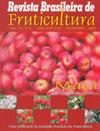Impact of heat waves on the bud dormancy of grapevines
IF 0.9
4区 农林科学
Q4 HORTICULTURE
引用次数: 0
Abstract
Abstract The objective of this work was to evaluate the effect of heat waves on the bud dormancy of grapevines with contrasting chilling requirements. ‘Chardonnay’, ‘Merlot’ and ‘Cabernet Sauvignon’ hardwood cuttings were collected in vineyards of Veranópolis, State of Rio Grande do Sul, Brazil, and were exposed to constant (7.2°C) or alternate (7.2 and 18°C for 12/12 hours) temperatures, combined with zero, one or two days a week at 25°C. Periodically, part of cuttings was transferred to 25°C for daily budburst evaluation. Endodormancy (dormancy controlled by cold) was overcome with 150 chilling hours (CH) at 7.2ºC in ‘Chardonnay’, 300 CH in ‘Merlot’ and 400 CH in ‘Cabernet Sauvignon’. Daily temperature cycles ranging from7.2ºC to 18°C did not affect the endodormancy process. Heat waves of 25°C resulted in increase in CH to overcome endodormancy. The negative effect of heat waves depended on their duration, with heat partially canceling out the chilling accumulation after 36 continuous hours on the dormancy. Such evidence shows that the dormancy evolution is affected by the impact of the heat interspersed with cold, and should be considered in the adjustment and/or development of better-adapted models for the prediction of the budburst potential of the grapevine culture in Southern Brazil.热浪对葡萄芽休眠的影响
摘要本研究旨在探讨不同低温条件下高温对葡萄芽休眠的影响。“霞多丽”、“梅洛”和“赤霞珠”的硬木切块收集于巴西南里约热内卢格兰德州Veranópolis的葡萄园,并暴露在恒定(7.2°C)或交替(7.2和18°C, 12/12小时)的温度下,每周1或2天在25°C的温度下零温度。定期将部分插枝转移至25°C进行每日发芽评估。霞多丽(Chardonnay)、梅洛(Merlot)和赤霞珠(Cabernet Sauvignon)分别在7.2ºC、300和400ºC的条件下克服了内生休眠(由寒冷控制的休眠)。从7.2℃到18℃的日温度循环对内休眠过程没有影响。25°C的热浪导致CH增加以克服内休眠。热浪的负面影响取决于其持续时间,在连续36小时后,热量部分抵消了休眠期间的冷积累。这些证据表明,休眠进化受到冷热穿插的影响,在调整和/或开发更好适应的模型以预测巴西南部葡萄藤培养的发芽潜力时应予以考虑。
本文章由计算机程序翻译,如有差异,请以英文原文为准。
求助全文
约1分钟内获得全文
求助全文
来源期刊
CiteScore
1.50
自引率
20.00%
发文量
34
审稿时长
4-8 weeks
期刊介绍:
The Revista Brasileira de Fruticultura (RBF) publishes technical articles and scientific communications in the area of fruit crops, referring to results of original searches and unpublished papers in Portuguese, Spanish or English, and 1 or 2 reviews per edition, of invited authors.

 求助内容:
求助内容: 应助结果提醒方式:
应助结果提醒方式:


